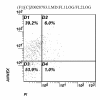Phenotype of apoptotic lymphocytes in children with Down syndrome
- PMID: 19267926
- PMCID: PMC2657904
- DOI: 10.1186/1742-4933-6-2
Phenotype of apoptotic lymphocytes in children with Down syndrome
Abstract
Background: Down syndrome (DS) is the most common and best-known chromosomal disorder and is associated with several other pathologic conditions including immunodeficiency which makes a significant contribution to morbidity and mortality. Various immunological theories and observations to explain the predisposition of individuals with DS to various infections have been published, one of which is increased apoptotic cells.
Aim: The aim of this study was to identify the effect of apoptosis on both types of cells of specific immune response (T and B lymphocytes) in children with DS using Annexin V staining of phosphatidyserine (PS) as a specific marker of early apoptosis.
Subjects and methods: The study included 17 children with karyotypically ascertained DS (7 males and 10 females). Their ages ranged from 4 months to 14 years with mean age of 5.7 +/- 4.35 years. Seventeen age and sex matched healthy children were included in the study as controls. Patients or controls with infections were excluded from the study. Complete blood picture, immunophenotyping, analysis of apoptosis using Annexin V was done at National cancer Institute to all children included in this study.
Results: Although CBC, differential count, relative and absolute number of CD(3+) and CD(16+) did not show significant differences between DS children and control group, the relative and the absolute size of apoptotic CD(3+) T lymphocytes, and the relative size of apoptotic CD(19+) B lymphocytes were significantly higher in DS children than in controls. On the other hand, no significant difference was detected as regards the absolute size of CD(19+) B lymphocytes in DS children and in controls
Conclusion: our finding of increased early apoptotic cells (especially T cells) in DS children may emphasize the fact that the function of cells- and not their number- is main mechanism responsible for the impairment of the immune system in DS children and may further add to the known fact that cellular immunity is more severely affected than humoral immunity in these children. Further studies on apoptotic cellular phenotype in larger number of DS are needed.
Figures


Similar articles
-
Increased circulating apoptotic lymphocytes in children with Down syndrome.Pediatr Blood Cancer. 2012 Dec 15;59(7):1310-2. doi: 10.1002/pbc.24246. Epub 2012 Jul 18. Pediatr Blood Cancer. 2012. PMID: 22811045
-
Lymphocyte populations and apoptosis of peripheral blood B and T lymphocytes in children with end stage renal disease.Ren Fail. 2014 May;36(4):502-7. doi: 10.3109/0886022X.2013.875833. Epub 2014 Feb 10. Ren Fail. 2014. PMID: 24512046
-
Age-related changes in humoral and cell-mediated immunity in Down syndrome children living at home.Pediatr Res. 1987 Nov;22(5):536-40. doi: 10.1203/00006450-198711000-00013. Pediatr Res. 1987. PMID: 2960948
-
Immunological features of Down's syndrome: a review.J Intellect Disabil Res. 1993 Dec;37 ( Pt 6):543-51. doi: 10.1111/j.1365-2788.1993.tb00324.x. J Intellect Disabil Res. 1993. PMID: 8124000 Review.
-
[Biological properties and sensitivity to induction therapy of differentiated cells expressing atypical immunophenotype in acute leukemia of children].Folia Med Cracov. 2001;42(3):5-80. Folia Med Cracov. 2001. PMID: 12353422 Review. Polish.
Cited by
-
Inflammatory and Immunological parameters in adults with Down syndrome.Immun Ageing. 2011 Apr 16;8(1):4. doi: 10.1186/1742-4933-8-4. Immun Ageing. 2011. PMID: 21496308 Free PMC article.
-
Commonality in Down and fetal alcohol syndromes.Birth Defects Res A Clin Mol Teratol. 2013 Apr;97(4):187-97. doi: 10.1002/bdra.23129. Epub 2013 Apr 3. Birth Defects Res A Clin Mol Teratol. 2013. PMID: 23554291 Free PMC article.
-
Consequences of chromosome gain: A new view on trisomy syndromes.Am J Hum Genet. 2022 Dec 1;109(12):2126-2140. doi: 10.1016/j.ajhg.2022.10.014. Am J Hum Genet. 2022. PMID: 36459979 Free PMC article. Review.
-
Expression of LDOC1 mRNA in leucocytes of patients with Down's syndrome.J Genet. 2012;91(1):95-8. J Genet. 2012. PMID: 22546831 No abstract available.
-
AKT Hyperphosphorylation and T Cell Exhaustion in Down Syndrome.Front Immunol. 2022 Feb 10;13:724436. doi: 10.3389/fimmu.2022.724436. eCollection 2022. Front Immunol. 2022. PMID: 35222360 Free PMC article.
References
-
- Nespoli L, Burgio GR, Ugazio AG, Maccario R. Immunological features of Down's syndrome: a review. J Intellect Disabil Res. 1993;37:543–51. - PubMed
-
- Cossariza A, Monti D, Montanani G, Ortolani C, Masi M, Zannoti M, Franceschi C. Precocious aging of the immune system in Down syndrome: alteration of B-lymphocyte, T lymphocytes subsets, and cells with natural killer markers. Am J Med Genet Suppl. 1990;7:213–8. doi: 10.1002/ajmg.1320370743. - DOI - PubMed
-
- Loh RK, Harth SC, Thong YH, Ferrante A. Immunoglobulin G subclass deficiency and predisposition to infection in Down's syndrome. Pediatr Infect Dis J. 1990;9:547–51. - PubMed
LinkOut - more resources
Full Text Sources

